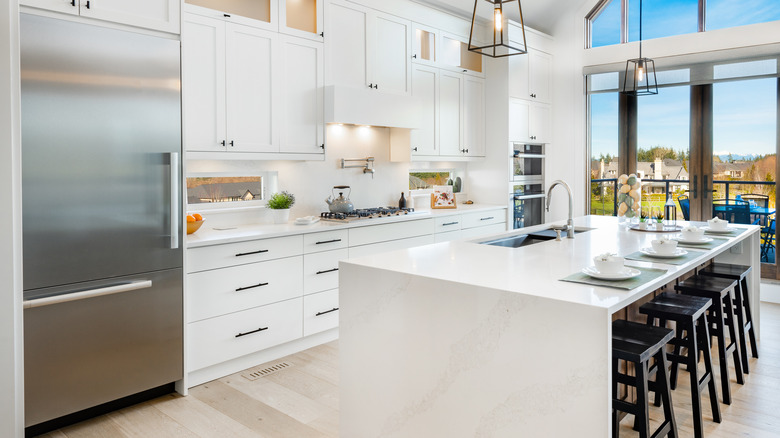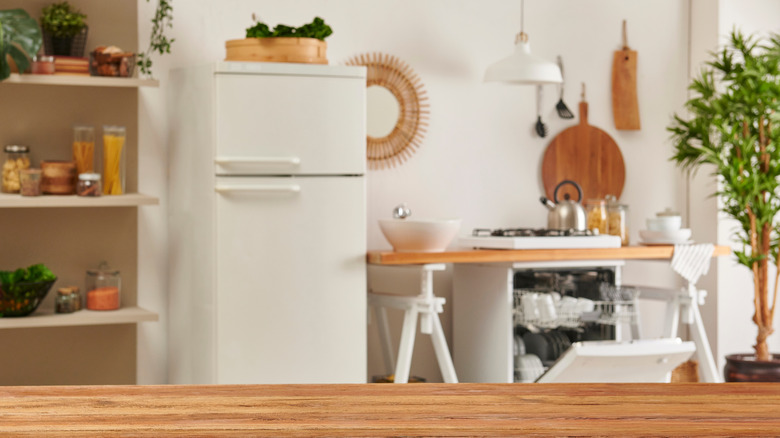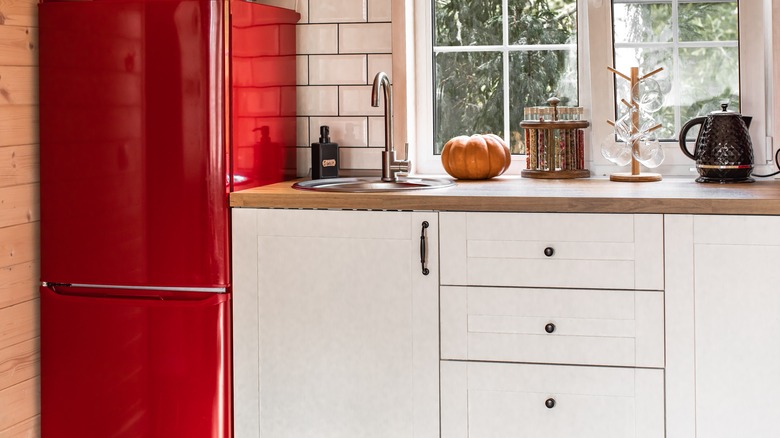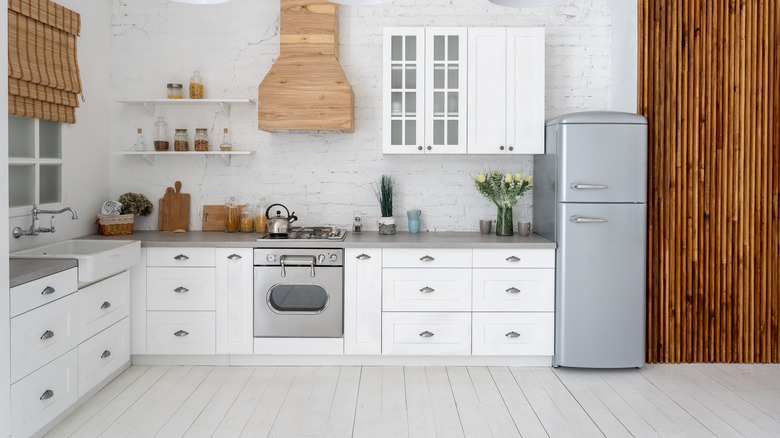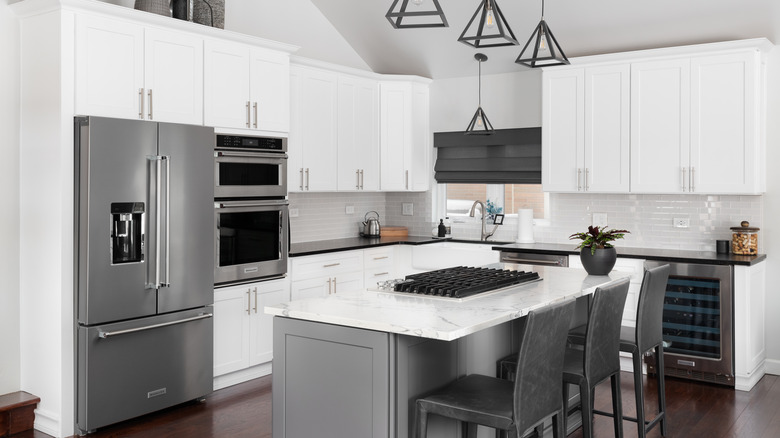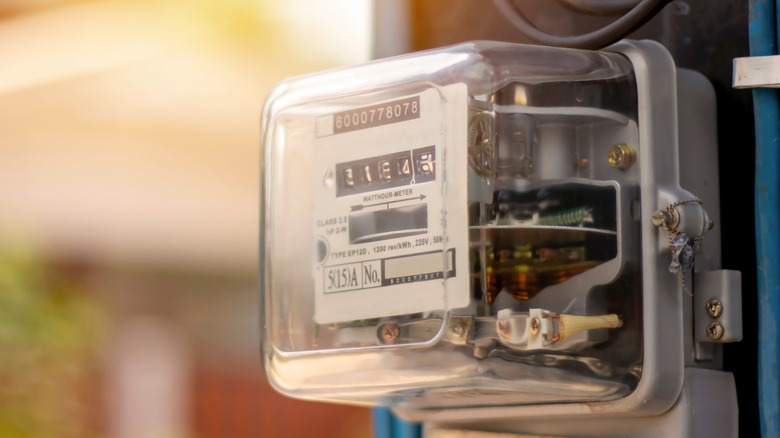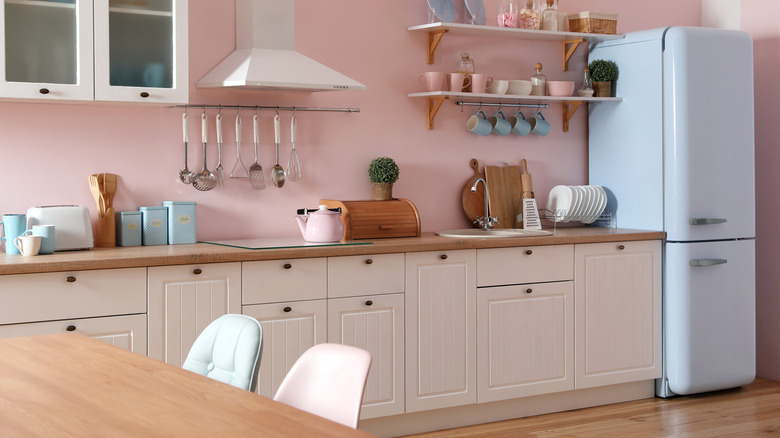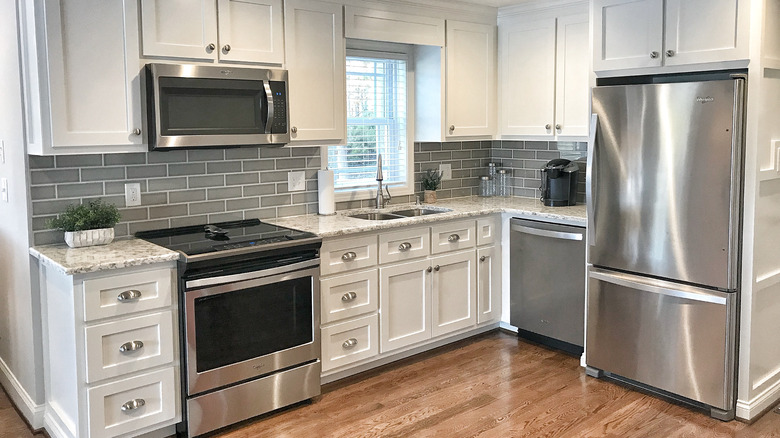Top-Freezer Vs. Bottom-Freezer Refrigerators: What's The Difference?
We may receive a commission on purchases made from links.
Designing your home, especially your kitchen, can be an extremely overwhelming process. With hundreds of different options, you can quickly become overburdened with information, and this is no different for big appliances. With their high price point and a major influence on the final look and functionality of your kitchen, you should spend a reasonable amount of time considering what works the best for you.
One simple place to start is with the refrigerator, as this purchase is not only costly but somewhat permanent. Appliance retailer Howard's, states that your fridge should theoretically last anywhere from 10 to 20 years. There are, of course, a vast array of options on the market when it comes to refrigerator designs. Do you want a silver, black, white, or wood-faced fridge? Do you want it to be modern and sleek, retro, rounded, or rustic farmhouse? And what about the freezer? — would you prefer it on the top or bottom of your refrigerator? Odds are, you may not even know yet. Or, you may like the look of one design, but another could be more beneficial to your lifestyle or budget. Besides the obvious visual elements, there are a handful of significant differences between these types of appliances.
How does the appearance differ?
The most obvious difference between the two refrigerator styles is, of course, where the freezer compartment is located. The nuances in appearance and design appear first in the freezer doors themselves. Most top-freezer refrigerators have a freezer with a door that pulls open on a hinge, whereas most bottom-freezer models have a deep, pull-out drawer.
There aren't too many functional differences between the two models, but there are some additional features that bottom-freezer fridges have, that a top-freezer model won't. For example, only bottom freezer or side-by-side door refrigerators include filtered water and ice dispensers, explains Albert Lee. While there aren't any specific design rules, bottom-freezer refrigerators often have a sleeker, more modern look and feel, whereas top-freezer designs tend to have a more classic and basic look. Alternatively, retro-styled refrigerators, like those sold by Big Chill, are most commonly found with only top freezers.
What are the differences in cost?
Another significant difference between top- and bottom-freezer refrigerators is the cost. According to Kitchn, top-freezer refrigerators tend to be cheaper and more energy-efficient. Bottom-freezer refrigerators can come with a host of upgrades, from a simple ice dispenser to fancy touch screens, making them much more expensive. The cheapest top-freezer, with 10 cubic feet of storage, costs around $360. However, for a comparable model with a bottom-freezer expect to pay in the region of $600.
On the higher end of the scale, a top-of-the-range refrigerator with a top-freezer that has 21.9 cubic feet of storage space, and comes with a lovely finger-proof resistant slate finish, is around $1,530. By comparison, the most expensive model of the bottom-freezer fridge has a 26 cubic feet capacity, Alexa/Google Home compatibility, a window, and a smudge-proof finish, and is considerably more expensive at $3,500 (via Best Buy).
Pros and cons of top-freezer refrigerators
Beyond the price differences, both top-freezer and bottom-freezer refrigerators have their own unique set of benefits and drawbacks. Beginning with top-freezer models, one of the bigger and more obvious pros is the lower price point. As Duerden's Appliance & Mattress points out, this type of fridge is timeless and outlasts other appliance trends. For what it lacks in advanced gadgetry, it makes up for in longevity. It's also cheaper to run, as it uses less energy than bottom-freezer models. In addition, according to Bray & Scarff Appliance & Kitchen Specialists, they're easier to lift heavy items in and out of.
Top-freezer models tend to have less overall storage, though, so they are not ideal for people who do large amounts of freezing. While the purchasing price may be cheaper due to a lack of modern add-ons, that may be a negative for those used to things like water and ice dispensers. Moreover, as Kitchn notes, top-freezer refrigerators don't tend to look as sleek or modern and may look out of place or outdated in a new contemporary kitchen.
Pros and cons of bottom-freezer refrigerators
Bottom-freezer refrigerators also have their own unique set of pros and cons. One of the bigger benefits is just that — the size. Bottom-freezer models tend to have more overall storage in both the fridge and freezer compartments. Additionally, Kitchn points out, that the fridge section is at eye level, making it convenient to look at all your food at once without having to bend down. There's also potential for fancy upgrades, like water and ice dispensers or Wifi connection. These refrigerators tend to be a lot sleeker, more modern, and trendier, and are a great finishing touch to a newly renovated kitchen.
However, all of those potential upgrades cost money, making bottom-freezer refrigerators significantly more expensive. It is also necessary to bend over to get your frozen produce in and out, making it a little more difficult for heavier items, Duerden's Appliance & Mattress notes. Bottom-freezer models also require more energy run, and if you opt for a water dispenser, you'll also have to replace the water filter on a regular basis.
What are the differences in energy use?
As with most modern appliances, a large part of the cost is simply operational. According to Now Power, the average cost of operating a modern fridge is about $27.60 per month. However, that number can fluctuate depending on factors like the voltage of the appliance and how much you pay for electricity per kilowatt-hour.
As such, different refrigerators have different operational costs. If you're wondering if there's a difference in energy use between top- and bottom-freezer fridges? The answer is yes. According to a U.S. Department of Energy report, top-freezer refrigerators use as much as 10 to 25% less energy than a comparable bottom-freezer model (via Albert Lee). This makes top-freezer refrigerators both cheaper upfront and also in the long run in terms of operation. Not only that, but having a fridge with lower energy consumption significantly reduces your environmental impact, too.
Differences in size
In general, top-freezer refrigerators are smaller than bottom-freezer refrigerators. This is in terms of cubic feet, width, height, and depth. According to Aztec Appliance, top-freezer models have an average fridge capacity of 7.5 to 18 cubic feet and an overall capacity of 10 to 25 cubic feet. On the other hand, bottom-freezer fridges have an average fridge capacity of 12.5 to 16 cubic feet with an overall capacity of 18 to 23 cubic feet, making them larger from the start in terms of internal storage.
Top-freezer models have an average width of 23 to 35 inches, a height of 64 to 68 inches, and an average depth of 23 to 33 inches. On the other hand, bottom-freezer models are larger on all fronts, with an average width of 29 to 35 inches, an average height of 66 to 68 inches, and an average depth of 25 to 34 inches.
When to chose top-freezer refrigerators over bottom-freezer refrigerators
The refrigerator you should choose should be influenced by all the factors discussed throughout this article. While there isn't a definitively better model or design, the best choice for you will be one that fits your lifestyle, budget, and priorities. Top-freezer refrigerators are the best option for people looking for a sturdy, classically styled fridge that won't break the bank, as they are often much cheaper than bottom-freezer models, as well as being energy and cost-efficient, says Aztec Appliances. They are also a better option for smaller kitchens and for people who can't bend constantly to lift things in and out of their fridges.
Bottom-freezer refrigerators are more suitable for people with a slightly larger budget and more kitchen space, and for those who prioritize the look and convenience of a product over its basic operational necessities. They're ideal for those who want to be able to be at eye level with their fresh produce and don't mind having to bend to lift their frozen items.
